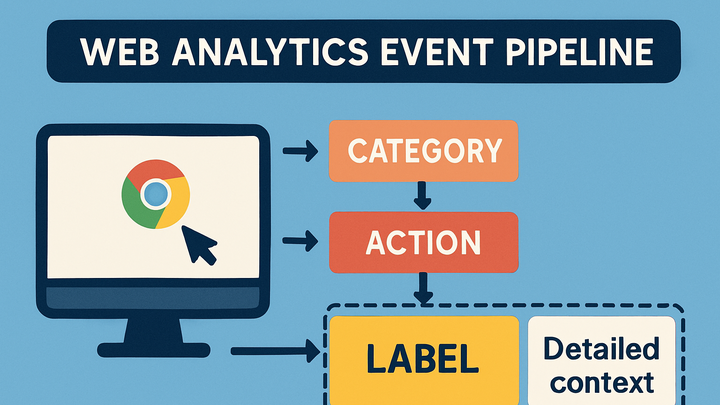Published on 2025-06-22T03:15:44Z
What is an Event Label? Examples in Analytics
In web analytics, an Event Label is an optional string parameter assigned to an event to provide additional context about the user interaction. It works alongside Event Category and Event Action to help categorize and describe granular details of user behavior. Many analytics platforms, including Google Analytics 4 (GA4) and PlainSignal’s cookie-free analytics, allow you to define custom labels to track elements like button names, link destinations, or form IDs. Proper use of Event Labels enables more precise filtering, segmentation, and reporting, which can drive data-driven optimizations. Understanding how to implement and structure labels consistently is crucial for maintaining clean, actionable analytics data.
Event label
Event Label is an optional analytics parameter for adding contextual detail to events, enhancing segmentation and reporting.
Definition of Event Label
The Event Label is an optional string parameter used in event tracking to describe the specific element or context of the user interaction. It is sent alongside the mandatory parameters Event Category and Event Action. Labels help differentiate between multiple items that share the same category and action, providing deeper insights into user behavior. While optional, consistently using Event Labels can significantly improve the granularity of analytics data.
-
Contextual descriptor
Labels act as descriptive identifiers—like ‘signup_button’ or ‘download_pdf’—to distinguish individual events.
-
Optional parameter
Not all analytics platforms require labels, but they are highly recommended for clarity when tracking diverse interactions.
-
Analytics platforms support
Supported by GA4 as a custom parameter and by PlainSignal’s event API for cookie-free tracking.
Why Event Label Matters
Using Event Labels drives more actionable insights by enabling detailed segmentation, filtering, and analysis of user interactions that would otherwise be grouped together. Labels are essential for understanding which specific elements contribute to key metrics like conversions, engagement, or drop-offs.
-
Granular insights
Labels let you distinguish between elements that share the same category or action—for example, tracking multiple buttons labeled ‘signup’.
-
Filtering and segmentation
You can filter reports by labels to isolate specific interactions without creating additional custom metrics or dimensions.
-
A/b test attribution
When running experiments, labels identify which variant the user interacted with, aiding in precise attribution of results.
Implementing Event Label
The implementation of Event Labels varies by analytics tool. Below are common patterns in GA4 using gtag.js and in PlainSignal with its lightweight, cookie-free API.
-
Google analytics 4
In GA4, include an ‘event_label’ parameter as part of the gtag(‘event’, …) call. Example:
-
Code example
<script async src='https://www.googletagmanager.com/gtag/js?id=GA_MEASUREMENT_ID'></script> <script> window.dataLayer = window.dataLayer || []; function gtag(){dataLayer.push(arguments);} gtag('js', new Date()); gtag('config', 'GA_MEASUREMENT_ID'); gtag('event', 'click', { event_category: 'button', event_label: 'signup_now', value: 1 }); </script>
-
-
PlainSignal (cookie-free analytics)
With PlainSignal, after including the tracking snippet, call ‘track’ with a label field. Example:
-
Code example
<script defer data-do='yourwebsitedomain.com' data-id='0GQV1xmtzQQ' data-api='//eu.plainsignal.com' src='//cdn.plainsignal.com/plainsignal-min.js'></script> <script> window.PlainSignal = window.PlainSignal || function(){(window.PlainSignal.q = window.PlainSignal.q || []).push(arguments);} PlainSignal('track', 'button_click', { category: 'navigation', label: 'main_menu_signup' }); </script>
-
Best Practices and Common Pitfalls
Follow these guidelines to ensure your Event Labels remain consistent, actionable, and compliant with privacy standards.
-
Use consistent naming
Adopt a standardized naming convention (e.g., snake_case) to avoid label fragmentation in reports.
-
Be descriptive
Choose clear, meaningful labels that accurately describe the element or context, such as ‘checkout_form_submit’.
-
Avoid personal data
Never include personally identifiable information (PII) in labels to comply with data protection laws.
-
Limit unnecessary variations
Too many unique labels can clutter reports. Use labels selectively for interactions that need differentiation.
